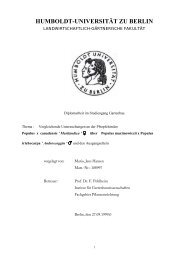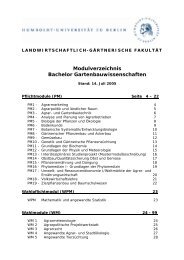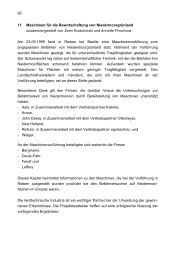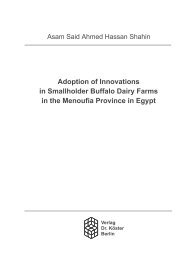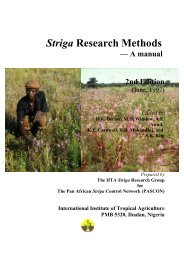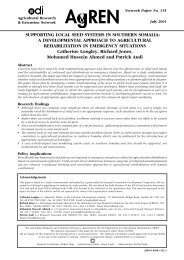Rice-Wheat Cropping Systems of the Indo-Gangetic Plain of India
Rice-Wheat Cropping Systems of the Indo-Gangetic Plain of India
Rice-Wheat Cropping Systems of the Indo-Gangetic Plain of India
Create successful ePaper yourself
Turn your PDF publications into a flip-book with our unique Google optimized e-Paper software.
declined from 4.8% (1971–80) to 3.8%<br />
(1981–90) to 3.2% (1991–95); and so has<br />
<strong>the</strong> production rate reduced from peak <strong>of</strong><br />
10.3 in 1971–80 to just 1.6% in 1991–95<br />
(Table 2). By contrast, <strong>the</strong> progress in rice<br />
has been very consistently positive<br />
throughout and hence priority needs to be<br />
given to steadying <strong>the</strong> wheat area to sustain<br />
RWCS in West Bengal. Focused attention<br />
should also be given to developing <strong>the</strong><br />
upper reaches <strong>of</strong> ACZ D1, where wheat<br />
area has shown a significant reduction.<br />
Adjoining Non-IGP Western Himalayas<br />
Region (Kumaon and Garhwal Hills <strong>of</strong><br />
Uttar Pradesh and Himachal Pradesh):<br />
Both rice and wheat individually seem to<br />
be declining in area, <strong>the</strong> extent being more<br />
severe and sharp in wheat than in rice<br />
(Figs. 24 and 16). The inference emerging<br />
is that RWCS is not capable <strong>of</strong> being<br />
sustained over extended areas in <strong>the</strong> hills,<br />
probably on account <strong>of</strong> uncertainty and<br />
inadequacy <strong>of</strong> water resources, continuous<br />
degradation <strong>of</strong> land resources, and poor or<br />
inadequate arrangements for procurement <strong>of</strong><br />
grains by <strong>the</strong> Government agencies in <strong>the</strong><br />
hills.<br />
Adjoining Non-IGP Eastern Plateau and<br />
Hills Region (Bihar): A steady decline in<br />
wheat area and production until 1991,<br />
followed by a steady rise, <strong>the</strong>reafter,<br />
indicates renewed interest <strong>of</strong> farmers in<br />
adopting RWCS (Fig. 25). A watershed<br />
management program aimed at harnessing<br />
rainwater storage to provide one irrigation<br />
at sowing to facilitate timely planting <strong>of</strong><br />
wheat or to provide at least one<br />
supplementary irrigation later in <strong>the</strong> crop<br />
cycle seems to hold <strong>the</strong> key for steadying<br />
RWCS in this region.<br />
Conclusions<br />
Even though <strong>the</strong>re are signs <strong>of</strong> area and<br />
yield plateau in RWCS <strong>of</strong> <strong>the</strong> “Green<br />
Revolution” areas <strong>of</strong> Punjab and Haryana, it<br />
is suggested that <strong>the</strong> system is sufficiently<br />
robust to get over <strong>the</strong> present temporary<br />
and transitory emerging problems <strong>of</strong> (i)<br />
receding water-table, (ii) skewed cropping<br />
patterns focused around rice-wheat in <strong>the</strong><br />
hub-position, and (iii) <strong>the</strong> emerging<br />
problems <strong>of</strong> depleting soil fertility. The<br />
solutions to <strong>the</strong>se problems are known but<br />
need to be applied diligently to sustain<br />
RWCS at a well-stabilized high productivity<br />
level, without much possibility <strong>of</strong> fur<strong>the</strong>r<br />
degradation. One immediate priority task<br />
would be to develop agro-technology to<br />
organically recycle <strong>the</strong> vast bio-mass (crop<br />
residue, <strong>of</strong> rice and wheat : 12–16 million<br />
tonnes) which is burnt annually, causing a<br />
serious waste <strong>of</strong> precious nutrient resource<br />
33



